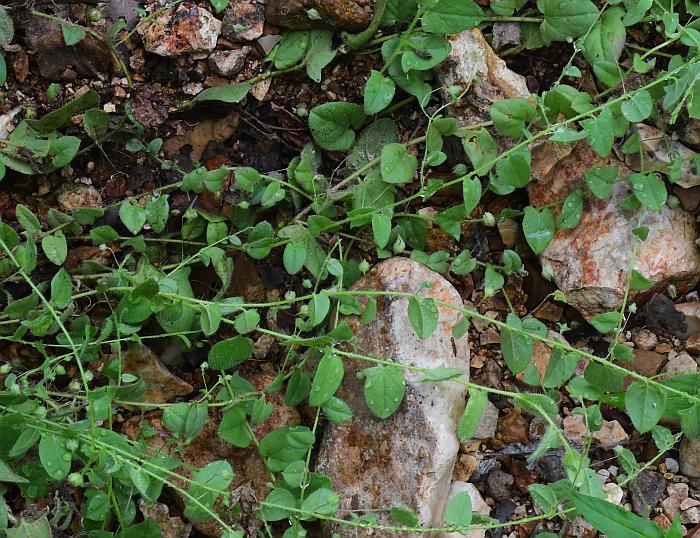Kickxia elatine (L.) Dumort.
Cancer Root

Introduced
CC = *
CW = 3
MOC = 26
© SRTurner
Kickxia elatine (L.) Dumort.Cancer Root | |
 |
Introduced CC = * CW = 3 MOC = 26 |
© SRTurner |
|
Family - Plantaginaceae Habit - Taprooted annual forb. Stems - Prostrate to loosely spreading, to 50 cm, sometimes twining and climbing on surrounding vegetation, branching, densely pubescent with short and long, multicellular hairs, some of these gland-tipped.
Leaves - Mostly alternate, simple, short-petiolate. Petiole to 5 mm long, pubescent. Blades 1-3 cm long, broadly ovate to halberd-shaped, at least some with a small pair of slender, spreading basal lobes, rounded or less commonly angled to a bluntly pointed tip, rounded to truncate or cordate at the base, the margins entire or with relatively coarse, blunt teeth, pinnately veined or sometimes the smaller leaves appearing more or less palmately 3-or 5-veined from at or near the base, the surfaces and margins densely pubescent with fine, spreading, multicellular hairs, some of the hairs sometimes gland-tipped.
Inflorescence - Single axillary flowers along the length of the stem. Pedicels thin, mostly spreading at 90 degrees to the stem, 5-14 mm long, becoming elongated to 8-25 mm at fruiting, usually pubescent only toward the tips.
Flowers - Perfect. Calyces deeply 5-lobed nearly to the base, the lobes lanceolate to ovate, sharply pointed at the tip, pubescent with fine, spreading, multicellular hairs, the hairs usually nonglandular. Corollas spurred, bilabiate, 5-lobed, 6.5-11.0 mm long (including the spur), spreading-hairy on the outer surface, especially on the tube, the tube somewhat shorter than the lobes, light yellow, the upper lip 2-lobed, the lobes arched or bent upward, rounded and purple, the lower lip with the lobes more or less spreading, the tube with a well-developed, slender spur 3.5-5.5 mm long at the base (this positioned between the lower 2 calyx lobes), the throat closed by the noticeably convex base of the lower lip. Fertile stamens 4, the filaments of 2 lengths, not exserted, the anther sacs spreading, hairy along the margins; staminodes absent. Style 1, not exserted, the stigma capitate, unlobed. Ovary superior, subtended by a green ring-like nectary, pubescent, green, globose, 1 mm in diameter, 2-locular. Placentation axial. Ovules many.
Fruits - Capsules 3.0-4.5 mm long, globose or nearly so, minutely glandular-hairy on the outer surface, the 2 locules equal in size, dehiscent circumscissilely above the midpoint (the upper half of each valve shed). Seeds numerous, 0.8-1.2 mm long, oblong to oblong-ovate, oblong-elliptic, or more or less rectangular in profile, not flattened, the surface dark brown, with a network of convoluted ridges, these sometimes appearing winglike.
Flowering - May - October. Habitat - Sand and gravel bars along streams, bottomland prairies, pond margins, railroads, open disturbed areas. Origin - Native to Europe. Lookalikes - K. spuria. Other info. - This inconspicuous species is found in scattered counties mostly south of the Missouri River. Its range extends in a highly scattered band eastward to the Atlantic Coast, with a disjunct distribution also occurring along the west coast. It is not particularly common. The plant is recognized by its prostrate habit, hairy and somewhat pale green foliage, and tiny flowers. At least some of the leaves have basal lobes. Though very small, the flowers are colorful and interesting up close. The lookalike species, K. spuria (L.) Dum., differs by having all more rounded, unlobed leaves and uniformly hairy flower stalks. It is less common in the state. Photographs taken on the shores of the Current River, Shannon County, MO., 7-18-03 (DETenaglia); also at Shaw Nature Reserve, Franklin County, MO, 10-4-2016, and along Fox Creek, St. Louis County, MO, 9-2-2020 (SRTurner). |